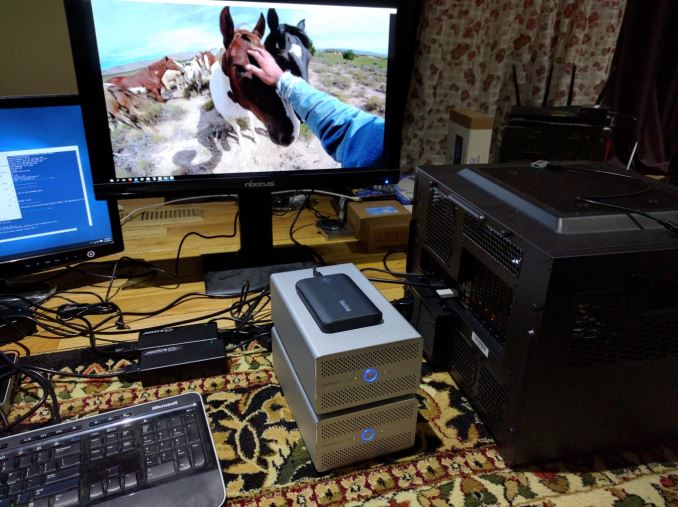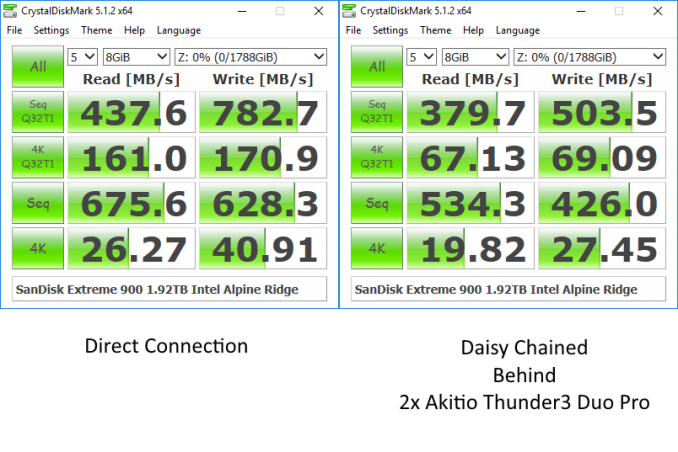Thunderbolt 3 in Action: Akitio Thunder3 Duo Pro DAS Review
by Ganesh T S on April 14, 2016 8:30 AM EST- Posted in
- Storage
- DAS
- Thunderbolt 3
- Akitio
Daisy Chaining
The full capabilities of Thunderbolt 3 are brought out when we have a series of devices hooked up in a daisy chain fashion to the testbed. Thunderbolt has always supported DisplayPort monitors at the end of a daisy chain. With Thunderbolt 3, any USB device with a Type-C interface can terminate the chain. The design of the Akitio Thunder3 Duo Pro ensures that a DisplayPort monitor does not need to be a link in the daisy chain, but can hang off as a node. We performed some testing with the following daisy chain configuration:
- AnandTech Skylake DAS Testbed with 2x Thunderbolt 3 (TB3) ports
- TB3 Port 1 of testbed connected to TB3 Port 1 of Akitio Thunder3 Duo Pro A
- TB3 Port 2 of Thunder3 Duo Pro A connected to TB3 Port 1 of Thunder3 Duo Pro B
- Nixeus Vue-27D 2560x1440 DisplayPort monitor connected to DisplayPort output of Thunder3 Duo Pro B
- SanDisk Extreme 900 1.92TB connected to TB3 Port 2 of Thunder3 Duo Pro B
The daisy chain setup is brought out in the photograph below.
IOMeter is one of the most reliable tools to measure performance while accessing multiple storage nodes simultaneously. In order to get maximum performance, we set up the two Akitio Thunder3 Duo Pro units in JBOD mode. Including the SanDisk Extreme 900, we ended up with five different physical disks that could be accessed over the single Thunderbolt 3 link. We ran the standard 128K sequential accesses with a queue depth of 4 and the 4K random accesses with a queue depth of 32. The table below shows the bandwidth realized as a function of the number of disks accessed simultaneously.
| 2x Akitio Thunder3 Duo Pro with 4x Intel SSD DC S3510 + SanDisk Extreme 900 (Thunderbolt 3 + USB 3.1 Gen 2 Daisy Chaining) IOMeter Benchmarks (MBps) |
||||
| Number of Simultaneous Disk Accesses | Write Bandwidth | Read Bandwidth | ||
| 128K Seq QD4 | 4K Rand QD32 | 128K Seq QD4 | 4K Rand QD32 | |
| 1 | 243.30 | 45.39 | 334.51 | 226.95 |
| 2 | 508.89 | 198.69 | 671.14 | 178.00 |
| 3 | 749.80 | 199.19 | 943.28 | 159.88 |
| 4 | 1010.37 | 160.12 | 1229.20 | 131.81 |
| 5 | 1489.72 | 172.68 | 1761.13 | 153.85 |
The sequential access numbers show that the link is nowhere near getting saturated despite pushing across more than 1700MBps (not accounting for the DisplayPort bandwidth here). However, with two bay devices supporting only SATA drives, it is difficult to sustain more traffic than what we have recorded here. That said, as more peripherals start coming out (in the form of docks or even units with 10+ drive bays), Thunderbolt 3 can show its true benefits.
Performance Implications
Daisy chaining is a nifty feature, but users must realize that as one goes further down the chain, the performance of the peripheral decreases. We studied this aspect further by using the SanDisk Extreme 900 USB 3.1 Gen 2 Portable SSD. In our first test, we connected the portable SSD directly to the Thunderbolt 3 port of the testbed. CrystalDiskMark was run with Alpine Ridge acting as a pure USB 3.1 Gen 2 host. In the second test, we connected the portable SSD to the free Thunderbolt 3 port on the Thunder3 Duo Pro that was farthest from the testbed (in the configuration mentioned at the top of this section).
The numbers clearly show a significant drop in performance as the peripheral gets further and further away from the main system. Similar drop in performance was noted for ATTO and all our real-life benchmarks (robocopy and PCMark 8 storage bench) also.












60 Comments
View All Comments
bill44 - Saturday, April 16, 2016 - link
Agreed. If performance is what you seek, this maybe it;https://www.cinema5d.com/faster-than-fast-sonnet-f...
philipma1957 - Saturday, April 16, 2016 - link
I am more of a Mac guy then a Windows or a linux guy.I own 3 macs
I own 3 windows pcs
I own a linux pc
Thunderbolt is all over my home and I use it for a lot of IT work on Macs.
A portable 2 drive piece of gear like this allows for rescue work.
Simply have a ssd in one slot with a mac os and a blank ssd 2tb samsung. go to a clients place
boot with it and then clone and rescue the dead mac's hhd on the big ssd in your other slot.
I do this now with an older version of thunderbolt then this one. Works great.
I have owned a dozen thunderbolt devices and they are day and nigh over most usb3 devices in terms of being a reliable stable external booter. None of this matters to most none mac users.
One of the great features is I can plug in a thunderbolt mac os and boot most macs.
Windows never really allowed this. So to complain about a system like thunderbolt costing too much is okay but the truth is when you realize what thunderbolt 1 and thunderbolt 2 can do to and with someone else's mac you would say that it is too cheap .
LuxZg - Sunday, April 17, 2016 - link
Is it just me or did you really comparr a performance of USB 3.1 Gen.2 SSD connected directly to PC's GEN2 port, vs it connecting to GEN1 port of a DAS and claimed that performance drop is purely due to DAISY CHAINING?ganeshts - Sunday, April 17, 2016 - link
Nope.The USB 3.1 Gen 2 SSD is first connected to a PC's Gen 2 port.
In the second case, it is connected to the Thunderbolt 3 port of the second DAS unit. Note that Thunderbolt 3 can support both Thunderbolt peripherals as well as USB 3.1 Gen 2 devices for daisy chaining. Only obvious restriction is that USB 3.1 Gen 2 devices can appear only at the end of the daisy chain.
Also, please read specifications carefully for the USB 3.1 Gen 1 port of the DAS - The Gen 1 port is a device port - i.e, it can connect to a PC directly. It can't connect to another device like the Extreme 900 Portable SSD.
Zizy - Monday, April 18, 2016 - link
1.) Could you please add USB 3.1 results for direct-attached? (just use USB cable instead of thunderbolt). Presumably the same, right? So, what is the point of Thunderbolt here? Daisy chaining?2.) Temperature is steadily increasing in your test. 10 minutes is quite short-ish test. What is the steady-state temperature and does it throttle at that temperature?
ganeshts - Monday, April 18, 2016 - link
(1) The USB 3.1 port is USB 3.1 Gen 1 - Maximum possible bandwidth on that is theoretically 5 Gbps, but, in practice, for RAID-0 SSDs, one would get around 450 - 500 MBps. So, it will not be the same as that of Thunderbolt 3 - where we could get around 800 MBps(2) Temperature for SSD configuration was with the fans completely turned off. You can see that the fan 'on' case for HDDs shows that even after more than 250GB of continuous data transfer, the temperature of the HDDs is within 5C of the temperature prior to the start of the transfers. I don't expect throttling to be a concern. If it is (depending on the SSD or HDD in use), one should just turn on the fan.
Haravikk - Tuesday, April 19, 2016 - link
Pretty underwhelming for the enormous price; USB3 is fast enough to handle three or even four drives if there's hardware RAID on the other end, so Thunderbolt only really offers an improvement if you're handling a JBOD enclosure, and even then two drives won't really justify it.Also, for the price, why aren't these hot-swap bays? Someone wanting to use paired drives in a mirror setup would benefit from being able to hot-swap in a replacement, and for the money you're spending I'd think that pretty reasonable.
Lastly, couldn't this be bus-powered? Even 3.5" drives shouldn't require so much power the bus can't handle it, plus any good RAID controller should be able to spin them up separately (so you're not drawing peak power for both drives simultaneously).
I dunno, I get that Thunderbolt is still a premium product, but it still feels as though the actual quality of design and features you're getting is severely lacking. Besides, being the first Thunderbolt 3 enclosure for two SATA III drives is meaningless as even Thunderbolt 1 is more than fast enough for that. Even the bigger "high end" enclosures are surprisingly poorly made and thought out for the amount of money you need to drop on them; a networked iSCSI device using ZFS with l2ARC will meet most needs, and the NAS/SAS options are just way better.
Questor - Tuesday, April 19, 2016 - link
I believe computing and related has come to a point where it needs an official organization to manage and assign acronyms.Chad - Tuesday, April 19, 2016 - link
As a thunderbolt user, there are several other benefits (especially for Mac's) that is brings to the table. For example, I added an external HDD, then added 5 more, 1 by 1 as time went on and as needed, for a total of 6, but only using the 1 port. On Mac's, ports are a valuable commodity. On this same iMac, I only had a few USB ports and they were quickly used up for various things. So that left the thunderbolt port... but i was able to connect 5 devices on it. None of them came even remotely close to using it's bandwidth, but for me, it wasn't about that, or about speed... but expandability. That is something worth noting, for sure. Granted, in PC land, this isn't really a concern, but on Mac's, it's a huge thing. There's also an aesthetic factor to daisey chaining, over a spiderweb hub solution.Haravikk - Wednesday, April 20, 2016 - link
True, but my main point was that you're paying a pretty big premium for the Thunderbolt aspect of this device, for what is overall a pretty poor product; two 3.5" bays, not really setup well for 2.5" drives, not hot-swappable, not actually all that compact. Even little things haven't been thought through, like the place of the Thunderbolt ports under the fan, limiting you to a smaller fan size (bigger is always better when it comes to noise after all).Also, technically it's possible to create daisy-chained USB devices too (each one would integrate a three port hub, with one port for whatever it actually does), the only difference with Thunderbolt really is that it's a crucial part of the design so manufacturers are forced to enable chaining, whereas USB device manufacturers are happier cutting their costs and forcing us to rely on hubs.
Also, if I've understood you right and you've got six HDDs, I'd seriously consider an 8-bay NAS instead. If you're fine with command line stuff then you can set that up with ZFS backed iSCSI, format the iSCSI volume as ZFS on your mac and assign it a chunk of your internal drive as a cache, and it's just better overall (if a little complex to setup in the first place). If someone manufactured a Thunderbolt cache device that I could plug straight between a Mac and a NAS then that would be the perfect option, but until then it's big local cache plus NAS with tons of drives for me =)